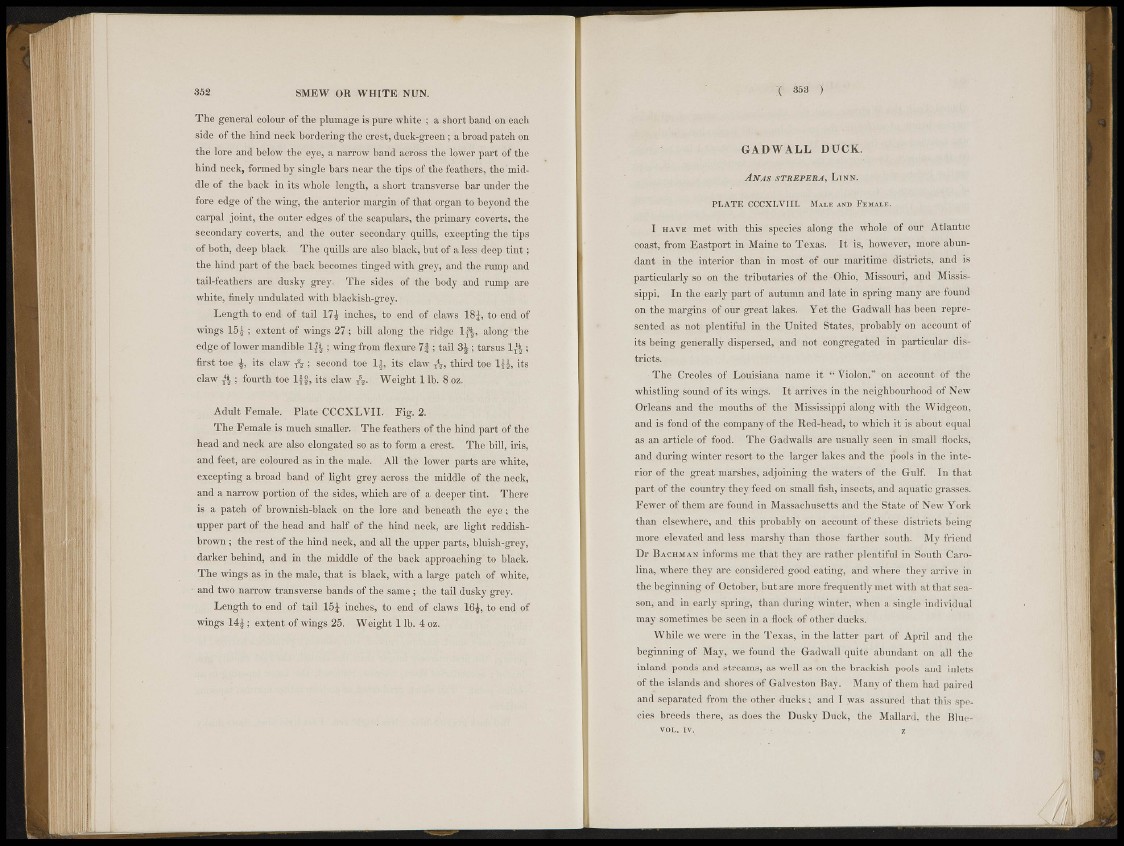
352 SMEW OR WHITE N0N.
Tho general colour of the plumage is pure white : a shorthand (Sweach
side of the hind neck bordering tlui duck-green ; a broad patch on
the lore and below the eye., a narrow band acro.-s tlio'lower part'of the
hind neck, formed by single bars near the tips of the feathers, the middle
of the back in its/ whole length, a Short transverse bar under the
fore edge of tlljgwing, the anterior margin of that organ to beyond the
carpal joint, tho Muter edges of the scapulars, the primary ojiyerts, the
secondary coverts, and the outer-,«ctómdnrv quij||: excepting the tips
of both, deep black. The quills are also black, but of a less; de'èp tint';
the hind part of the back becomes tinged with grey, and the rump1 and
tail-feathers are dusky grey, 'l'ho sides of the body and rump are
white, finely undulated with blackish grey.
Length to end g'f tail 17| inches, to end of «laws 18j. to end of
wings 15.J : extent of wings 27 ; bill along the ridge along the
edge of lower mandible 1 f t ; wing from flexure 7 | ; tail ii| : tarsus 1 ,'j ;
first toe J, its claw ft : second toe 1,],. its claw A/jnird toe Itj, its
claw ft ; fourth toe 1JJ, its claw ft, Weight ,1 lb. 8 ;0?,
Adult Female. 1'Iatc CCCXLVIi. Fig. 2.
The Female is. much smaller. The, feathers of the hind part of the.
head and neck are also elongated so as to form a crest. Thè bill, iris,
and feet, are coloured as in. thé; maie,. All the lower parts are white,
excepting a broad band of light grey across thè middle of the neck,
and a narrow portion of the sides, which are of a deeper lint. There
is a patch of brownish-black on the lore anil beneath theJw.ef; the
upper part of the head and half' of: the hind neck, ajfe light reddishbrown
; the rest of the hind neck, and :atl the upper parts, bluish-grey,
darker behind, and in the middle of the back approaching to black.
The wingg.(as in the male, thatpj| black, with a large patch S i white,
and two narrow transverse bands of the same ; the tail dusky grey.
Length to end of tail 15J inches, to end of claws Mty, to end of
wings ; extent of wings 25. Weight 1 lb. 4 oz.
353 )'
G A D W A L 1 DUCK.
ANAS STREPERA, Linn.
PLATE CCOXI.VJU. MALE ASP Éemali.
I have met with this species along the whole of Our Atlantic
coast, from Kaslport in Maine to Texas. It is, however, more abundant
in the interior than in most of our maritime districts, and is
particularly :•§» on the tributaries of the Ohio, Missouri, and Mississippi^
In the early part of autumn and late in spring many are found
on the margins of our great lakes. Yet the Gadwall háá been represented
as not plentiful in the United States', probably on account of
its being generally dispersed, and nut congregated in particular districts.
The Creoles of Louisiana name it Violoni" on account of the
whistling sound Sf its wings. It arrives in the neighbourhood of New
Orleans and the mouths of tlíe Mississippi along with the W idgeou,
and is fond of the company of the Red-head, to which it is about equal
as an arricle.of food. The Gadwails are usually seen in small flocks,
and during winter resort to the larger lakes and the pools ill the interior
of the great marshes, adjoining the waters of the Gulf. In that
part of the country they feed on small fish, insects, and aquatic grasses.
Fewer of them are. found in Massachusetts and the State of New York
than elsewhere, and this probably on account of these districts being
more elevated and less marshy than those farther south. ' My friend
Dr Hactim a s ' informs me that they are rather plentiful fa South Carolina,
where they aré considered good eating, and where they arrive in
the: beginning of October; but are more frequently met with at that season,;
and in early spring, than during winter, when a single individual
may sometimos bo. seen in a flock of other ducks.
While we were fa the Texas, fa the latter part of April and the
beginning of May, we found the Gadwall quite abundant on all the
inland ponds and streams, as well as on the brackish pools and inlets
óf the islands and shores of Galveston Bay. Many of thom had paired
and separated from the other ducks; and I was assured that this species
breeds there, as does the Dusky Duck, the Mallard, the Blue-
. . v o l . ly._ - - . z